
|







(alphabetical and illustrated) Introduction | A - 1 | A - 2 | B - 1 | B - 2 | C - 1 | C - 2 | C - 3 | D | E | F G - H | I - J - K | L - M | N - O | P | Q - R | S - 1 | S - 2 | T | U - V - W - X - Y - Z |
|
|
|
|
(or B-Movie, B-Picture) |
an off-beat, low-budget, second-tier film, usually from an independent producer; they were predominant from the 1920s to the late 1940s; they were shot quickly with little-known, second rate actors, short run times, and low production values; often the second film (or the 'lower half') of a double-feature, and paired with an A-feature; the vintage B-movie began to decrease in the 50s, or morphed into inferior TV series; sometimes B-films were exclusively shown in a grindhouse, especially in the 50s and 1960s; as code restrictions waned in the late 60s, B-films often became exploitation films, which added sensational and catchy titles, campy acting, cheesy special effects, and gratuitous violence and sexuality (nudity); contrast to A-pictures (first-class, big-budget films with high-level production values and star-power); not to be confused with cult films, although some B-films attained cult status | 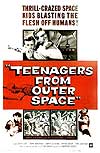 Examples:
John Wayne (Roy Rogers, Gene Autry, B-westerns, B-movie serials,
Fox's Charlie Chan mysteries, Monogram's Bowery Boys comedies, and
Universal's Ma and Pa Kettle and Sherlock Holmes, The Ghost of Frankenstein
(1942), a typical low-budget, sci-fi B-movies of the 50s - The
Beast with 1,000,000 Eyes (1955), and Teenagers From Outer Space
(1959); also Edgar G. Ulmer's Detour (1945). Examples:
John Wayne (Roy Rogers, Gene Autry, B-westerns, B-movie serials,
Fox's Charlie Chan mysteries, Monogram's Bowery Boys comedies, and
Universal's Ma and Pa Kettle and Sherlock Holmes, The Ghost of Frankenstein
(1942), a typical low-budget, sci-fi B-movies of the 50s - The
Beast with 1,000,000 Eyes (1955), and Teenagers From Outer Space
(1959); also Edgar G. Ulmer's Detour (1945). |
| refers to a large photographic backing or painting for the background of a scene (e.g., a view seen outside a window, a landscape scene, mountains, etc.), usually painted on flats (composed of plywood or cloth); a large curved backdrop (often representing the sky) is known as a cyclorama; backdrops were more commonly used before the current trend toward on-location shooting and the use of bluescreens. | 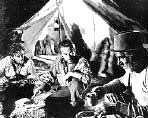 Example:
although filmed on location in Mexico, most of the night scenes in The
Treasure of the Sierra Madre (1948) were filmed on a studio set,
with backdrops or flats. Example:
although filmed on location in Mexico, most of the night scenes in The
Treasure of the Sierra Madre (1948) were filmed on a studio set,
with backdrops or flats. |
|
| refers to anything occuring in a rear plane of action (the background as opposed to the main action or attention in the foreground); abbreviated as b.g. | ||
| the individual who designs the visual background of a film scene, either traditionally painted or using digital technology; aka matte artist | ||
| refers to part of the score that accompanies a scene or action in a film, usually to establish a specific mood or enhance the emotion. | ||
| this phenomenon occurs when the lighting for the shot is directed at the camera from behind the subject(s), causing the figure(s) in the foreground to appear in semi-darkness or as silhouettes, or highlighted; with backlighting, the subject is separated from the background |
|
|
| an undeveloped area, on studio property, in an open-air, outdoor space away from the studio stages, where real-life situations with backgrounds can be filmed; contrasted to on-location shoots that are more expensive; various studios in the Los Angeles area offer back lot tours. | 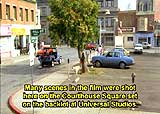 Examples:
big-city intersections, western streets are often filmed on back lots;
above is the backlot of Universal Studios where some scenes were shot
for Back to the Future (1985) Examples:
big-city intersections, western streets are often filmed on back lots;
above is the backlot of Universal Studios where some scenes were shot
for Back to the Future (1985) |
|
| a photographic technique whereby live action is filmed in front of a transparent screen onto which background action is projected. Back projection was often used to provide the special effect of motion in vehicles during dialogue scenes, but has become outmoded and replaced by bluescreen (or greenscreen) processing and traveling mattes; also known as rear projection or process photography (or shot); contrast to matte shot. |  Examples:
Any film with a moving vehicle and back-projected street scenes viewed
through the back or side windows, such as in To
Catch a Thief (1955). Examples:
Any film with a moving vehicle and back-projected street scenes viewed
through the back or side windows, such as in To
Catch a Thief (1955). |
|
| refers to the events that directly happened prior to the beginning of the story, or lead to the story; composed of information that helps fill out the skeletal story of a screenplay or a character's background, often to help actors (or the audience) understand motivation. |  Example:
the beginning of Casablanca (1942) provides
back story about the war, the locale of the film, etc.; a reversal of
back story is found in Memento (2000) Example:
the beginning of Casablanca (1942) provides
back story about the war, the locale of the film, etc.; a reversal of
back story is found in Memento (2000) |
|
| within a film's visual frame, refers to the composition, aesthetic quality, or working together of the figures, light, sound, and movement. |  Example:
from Sunset Boulevard (1950), a beautifully
balanced and composed frame Example:
from Sunset Boulevard (1950), a beautifully
balanced and composed frame |
|
| the blocking of a film's release (in a theatre showing or on video) by either the government or an official movie classification board, for political, religious, sexual, or social reasons; see also censorship. | 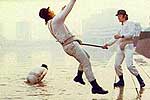 Examples:
director Stanley Kubrick voluntarily banned his own film A
Clockwork Orange (1971) in Britain for almost 30 years because
of copy-cat violence. And recently, the Academy award-winning film The
Tin Drum (1979) was seized and declared obscene by state law in
Oklahoma. Examples:
director Stanley Kubrick voluntarily banned his own film A
Clockwork Orange (1971) in Britain for almost 30 years because
of copy-cat violence. And recently, the Academy award-winning film The
Tin Drum (1979) was seized and declared obscene by state law in
Oklahoma. |
|
| the black metal folding doors an all four sides of a light that can be bent back and forth on their hinges to control where the light is directed. |  Lighting with Barn Doors |
|
| a blanket placed over the film camera to reduce the amount of noise of the moving mechanisms inside; see also blimp. | ||
| films that consist of a story line that has at least some basis in real historical events, and may actually contain only a few factual elements. These films, loosely based on various biographies, stories, or events, may/may not significantly alter the characters or situations for greater dramatic effect; inspired by a true story indicates the film is even looser with the factual basis of the events. | 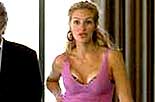 Examples: Braveheart
(1995) (an account of the life of medieval Scottish patriot William
Wallace), Raging Bull (1980) (based
on the life of middleweight boxer Jake LaMotta), and Erin
Brockovich (2000) (with Julia Roberts as the crusading single
mother) shown here. Examples: Braveheart
(1995) (an account of the life of medieval Scottish patriot William
Wallace), Raging Bull (1980) (based
on the life of middleweight boxer Jake LaMotta), and Erin
Brockovich (2000) (with Julia Roberts as the crusading single
mother) shown here. |
|
| refers to an actor's term for how long to wait or pause before doing an action; a beat is usually about one second; a "beat" is often interchangeable with a narrative device in a script known as an ellipse (designated in the text as "...") | ||
| the off-camera events or circumstances during filmmaking. |  Example:
The documentary Hearts of Darkness: A Filmmaker's Apocalypse (1991) chronicled
the sensational, behind-the scenes circumstances during the making of
Francis Ford Coppola's Apocalypse Now (1979). Example:
The documentary Hearts of Darkness: A Filmmaker's Apocalypse (1991) chronicled
the sensational, behind-the scenes circumstances during the making of
Francis Ford Coppola's Apocalypse Now (1979). |
|
| includes production expenses that are not above the line, such as costs of material, music rights, publicity, the trailer; opposite of above the line | ||
| the term for any technical assistant, apprentice or aide (regardless of sex) for the gaffer or the (key) grip on a set, responsible for the routing and coiling of power cables necessary to run the lights for a shot; also the 'best boy' schedules the people and equipment needed for a day's work; a gender-neutral term that came from whaling; aka Assistant Chief Lighting | ||
| 1/2 inch videotape that was originally called Betamax. |  Betamax cassette tape box |
|
| the placement or display of names of actors, directors, and producers for a movie in publicity materials, opening (or closing) film credits, and on theatre marquees. A person's status is indicated by the size, relative position, and placement of their name. Generally, higher positions closer to the top with larger and more prominent letters designate higher importance and greater box-office draw, and precede people of lesser importance; the most prominent actor that appears first is said to have top billing, followed by second billing, and so forth. | 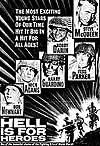 Example:
Notice top billing given to Steve McQueen in Hell is for Heroes (1962). Example:
Notice top billing given to Steve McQueen in Hell is for Heroes (1962). |
|
|
(or biographic) |
a biographical film of the life of a famous personality or historical figure, particularly popularized by Warner Bros. in the 1930s; a sub-genre of drama and epic films. |  Examples:
The Story of Louis Pasteur (1936), or The Life of Emile Zola (1937),
or the modern day Coal Miner's Daughter (1980) about Loretta Lynn. Examples:
The Story of Louis Pasteur (1936), or The Life of Emile Zola (1937),
or the modern day Coal Miner's Daughter (1980) about Loretta Lynn. |
|
(or bit player) |
a small acting role (usually only one scene, such as a waiter) with very few lines or acting; contrast to a cameo, extra, or walk-on role. | Example: Roger Corman making a brief appearance in The Godfather, Part II (1974) at the head table at Michael Corleone's Senate hearings. |
|
|
in shorthand, refers to the "business", or "show business". | |
|
|
simply means without color; before the invention of color film stock, all films were black and white; monochrome (literally meaning "one color") usually refers to a film shot in black and white, although it can refer to a film shot in shades of one color; grainy B&W is often used to convey authenticity; abbreviated as BW, B/W, and B&W; contrast to color. |  Example:
For artistic reasons, Peter Bogdanovich's The Last
Picture Show (1971) was purposely made in B&W. Example:
For artistic reasons, Peter Bogdanovich's The Last
Picture Show (1971) was purposely made in B&W. |
|
|
a type of comedy film, first popular during the late 1950s and early 1960s in which normally serious subjects, such as war, death, dismemberment, misery, suffering, or murder, are treated with macabre humor and satire through iconography, dialogue, and the characters; settings may include cemeteries, war rooms, funerals |
 Examples:
Hitchcock's The Trouble With Harry (1955), Dr.
Strangelove, Or: How I Learned to Stop Worrying and Love the Bomb (1964),
The Loved One (1965), Robert Altman's M*A*S*H (1970), Harold
and Maude (1972), Monty Python and the Holy Grail (1975), Whatever
Happened to Baby Jane? (1962), Prizzi's Honor (1985), Heathers
(1989), and Fargo (1996). Examples:
Hitchcock's The Trouble With Harry (1955), Dr.
Strangelove, Or: How I Learned to Stop Worrying and Love the Bomb (1964),
The Loved One (1965), Robert Altman's M*A*S*H (1970), Harold
and Maude (1972), Monty Python and the Holy Grail (1975), Whatever
Happened to Baby Jane? (1962), Prizzi's Honor (1985), Heathers
(1989), and Fargo (1996). |
|
(and blacklist) |
refers to late 40s and early 50s McCarthyism and the HUAC's (House UnAmerican Activities Committee) formal and informal discrimination and 'blacklisting' (effectively banning from employment) of various actors, artists and film-makers based upon their personal, political, social, or religious beliefs (i.e., "Communist sympathizers"); the blacklist was a roster of illegal artists who were not to be hired during the years 1947-1951. |  The
Hollywood Ten were a group of playwrights and moviemakers who refused
to answer questions claiming their First Amendment rights, and were charged
with contempt - they included Herbert Biberman, Lester Cole, Albert Maltz,
Adrian Scott, Samuel Ornitz, Dalton Trumbo, Edward Dmytryk, Ring Lardner
Jr., John Howard Lawson, and Alvah Bessie; also informally blacklisted recently
were Jane Fonda and Vanessa Redgrave for outspoken attitudes The
Hollywood Ten were a group of playwrights and moviemakers who refused
to answer questions claiming their First Amendment rights, and were charged
with contempt - they included Herbert Biberman, Lester Cole, Albert Maltz,
Adrian Scott, Samuel Ornitz, Dalton Trumbo, Edward Dmytryk, Ring Lardner
Jr., John Howard Lawson, and Alvah Bessie; also informally blacklisted recently
were Jane Fonda and Vanessa Redgrave for outspoken attitudes |